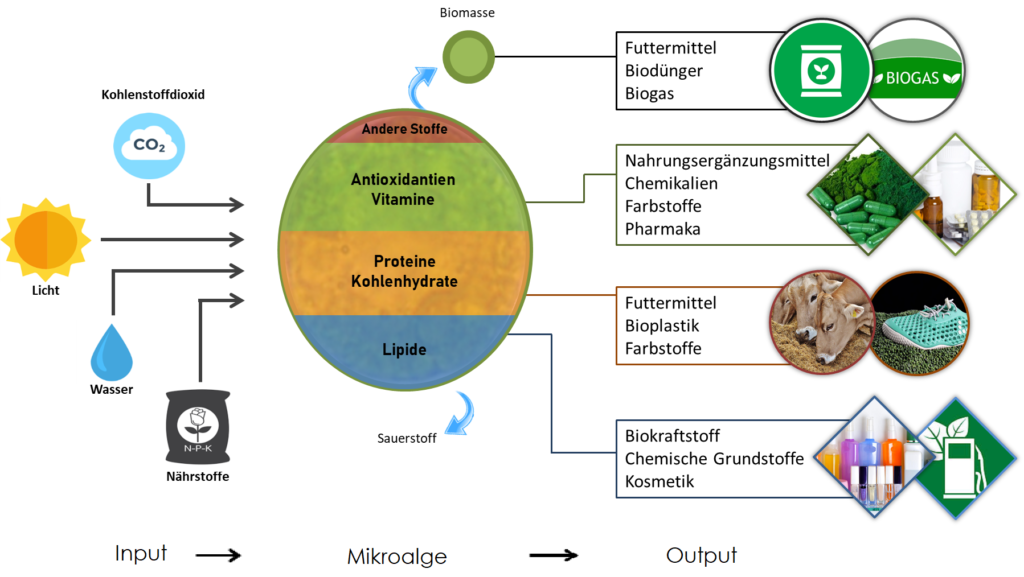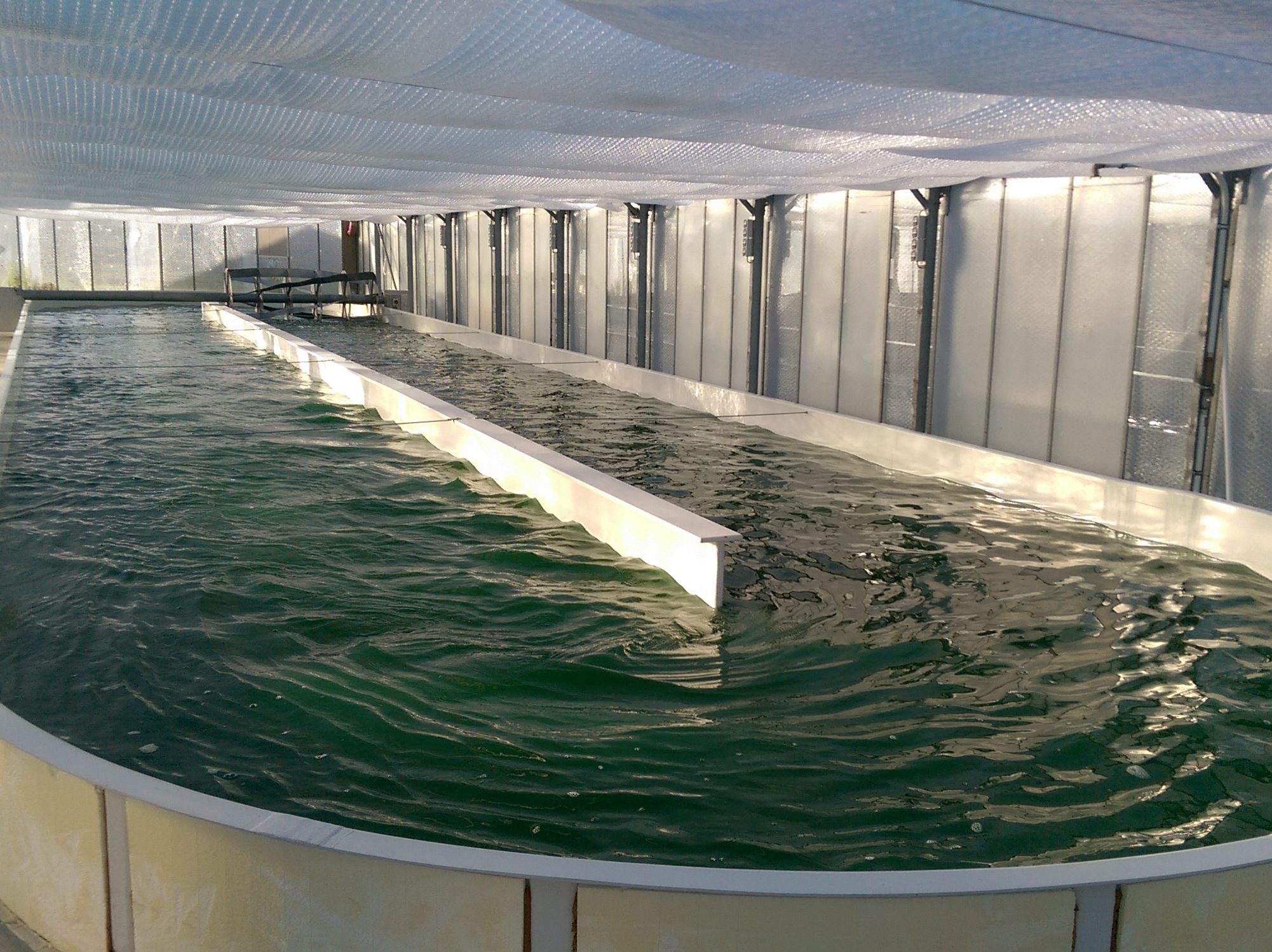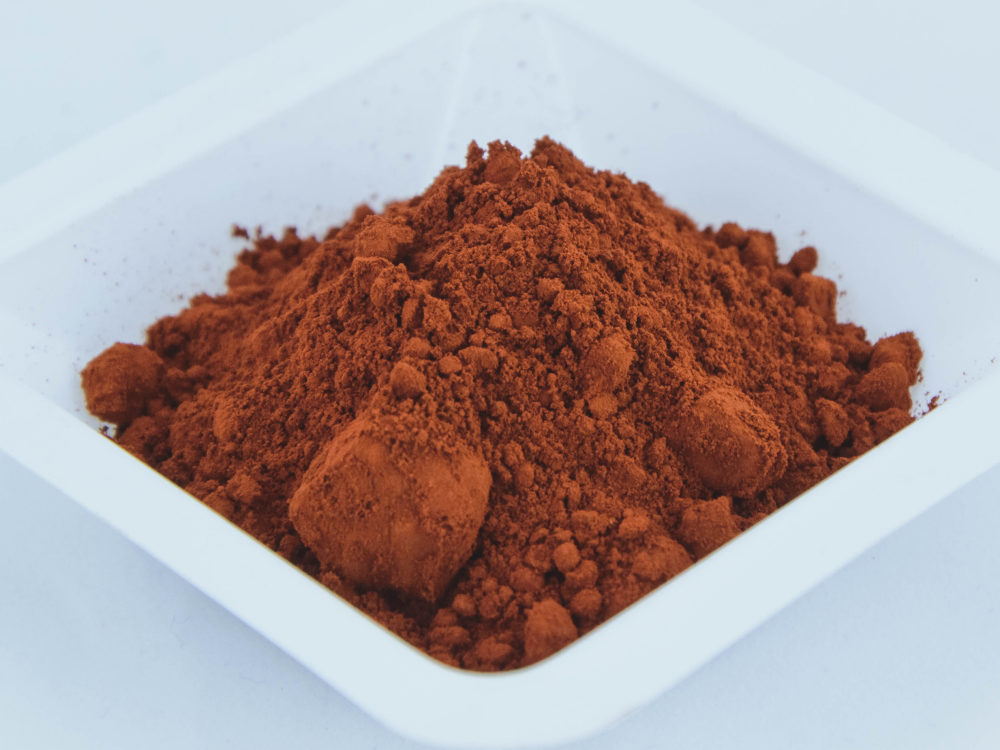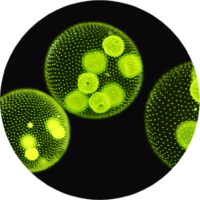
What are Microalgae?
Microalgae are a very diverse group of microorganisms that do photosynthesis and are widespread worldwide. Due to differences in structure, they are not considered to be higher plants. You can find them in the air, but above all in fresh and salt water. They differ in color, shape, size or metabolic products.
Microalgae have been around for millions of years. They play an essential role in the CO2 cycle and form the food base for all marine life. Some of them are less related than humans and mushrooms. The sizes range from 1µm to 400µm. This corresponds to a difference in size from fish to Eiffel Tower.
Only a few 10,000 species are known to date. However, it is estimated that there are still around 150,000 undescribed algae strains worldwide. Of the species known to date, around 20 are used today for the industrial production of ingredients for food supplements and animal feed, care products, oils or pharmaceuticals.
Microalgae are often confused with cyanobacteria. The latter are also incorrectly referred to as ‘blue-green algae’ and are often found in so-called algal blooms. Their bluish color pigments give them their cyan appearance. Since they are bacteria (prokaryotes) that do photosynthesis, they are not considered to be microalgae (eukaryotes). However, they are already used for industrial purposes (e.g. Spirulina).
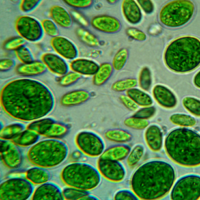
50%
of the world’s O2 is made by microalgae
50%
of the world’s CO2 is absorbed by microalgae
Algae as a sustainable raw material
The use of algae is of interest because they can produce a very broad repertoire of substances that are used in a variety of ways. Since the algae absorb CO2 and produce oxygen via photosynthesis, they are considered a particularly sustainable raw material. Compared to conventional plants, they take up less space, can grow in dry areas or in salt water, and do not require pesticides. Due to their plant-like amino acid spectrum, they can e.g. can be used as a feed additive and thus contribute to a reduction in soy production. The algae can also produce fats that can be used instead of palm oil, for example.
In addition, algae ingredients can be used as an equivalent to animal products and are therefore also interesting for vegans. Examples are omega-3 fatty acids (often from fish oil), squalene (often from shark’s liver oil) or astaxanthin (often from Antarctic krill). All of these substances can also be produced naturally with microalgae.
Microalgae production
In order to make the potential of the microorganisms usable for humans, a considerable amount of algal biomass has to be produced. The microalgae are grown in a nutrient solution under partially controlled conditions. Cell division creates more and more biomass. Ensuring the purity of the algae culture is important for later usability.
Various cultivation systems are used for biomass production. Some types of algae can be cultivated well in open vessels, so-called Open Raceway Ponds (picture left). For some microalgae species, special growth vessels first have to be developed. For example, closed glass tube systems (picture on the right) or semi-closed bubble columns (picture in the middle). The entire process of biomass production is called upstream.

In the subsequent downstream process, the biomass is separated from the water and processed further. These processes are technically very complex and expensive. Centrifuges or filtration techniques are often used for harvesting.
In the next steps, the harvested biomass is digested, dried and, if necessary, extracted. For the extraction of astaxanthin, for example, supercritical CO2 is used, which does not form any residues in the later product.
Little climate protectors
The first cyanobacteria lived on Earth about 2.4 billion years ago. It is believed that these very organisms have led to the Great Oxidation Event. This is due to the rise in atmospheric oxygen in the atmosphere to today’s level. Previously it was less than 1%. This can be traced using so-called stromatolites, which were formed by these microorganisms. And even today, algae are responsible for the production of around 50% of global oxygen. But not only that. Photosynthesis breaks down about 1 CO2 molecule and forms 1 O2 molecule. So algae also fix about 50% of the atmospheric carbon dioxide. Some of them can even remove the carbon from the cycle for a long time, thus counteracting climate change. So-called haptophytes play a special role here, a type of microalgae that mainly occurs in salt water. They are characterized by the fact that they form a calcareous shell in which a particularly large amount of CO2 is bound. When these microorganisms die, they sink to the bottom and form sediments on the sea floor that correspond to CO2 storage. Today’s oil deposits have emerged within millions of years. Today we burn in our power plants and heating systems as ancient microalgae biomass.
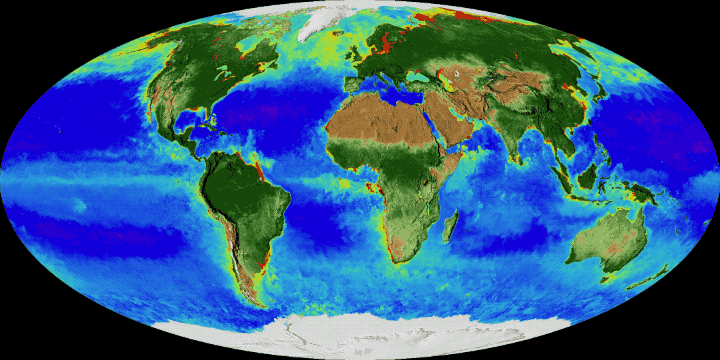
Scientists have been trying to recreate the process of fuel production using microalgae for many years. Quasi to shorten the natural petroleum formation process in the laboratory to a few weeks or months. The resulting biofuel is CO2 neutral. And it works! Cars and even planes have been successfully tested with this biofuel. However, since the manufacturing costs are too high, it will still take a while until there is possibly a green alternative made from algae. However, with the increasing scarcity of global oil resources and social change towards a sustainable bioeconomy, the new fuel could soon gain momentum.
What are Microalgae?
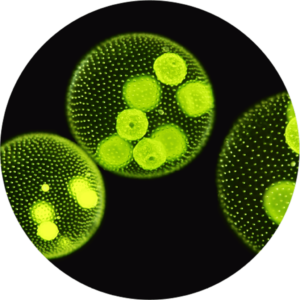
Microalgae are a very diverse group of microorganisms that do photosynthesis and are widespread worldwide. Due to differences in structure, they are not considered to be higher plants. You can find them in the air, but above all in fresh and salt water. They differ in color, shape, size or metabolic products.
Microalgae have been around for millions of years. They play an essential role in the CO2 cycle and form the food base for all marine life. Some of them are less related than humans and mushrooms. The sizes range from 1µm to 400µm. This corresponds to a difference in size from fish to Eiffel Tower.
Only a few 10,000 species are known to date. However, it is estimated that there are still around 150,000 undescribed algae strains worldwide. Of the species known to date, around 20 are used today for the industrial production of ingredients for food supplements and animal feed, care products, oils or pharmaceuticals.
Microalgae are often confused with cyanobacteria. The latter are also incorrectly referred to as ‘blue-green algae’ and are often found in so-called algal blooms. Their bluish color pigments give them their cyan appearance. Since they are bacteria (prokaryotes) that do photosynthesis, they are not considered to be microalgae (eukaryotes). However, they are already used for industrial purposes (e.g. Spirulina).
50%
of the world’s O2 is made by microalgae
50%
of the world’s CO2 is absorbed by microalgae
Algae are sustainable
The use of algae is of interest because they can produce a very broad repertoire of substances that are used in a variety of ways. Since the algae absorb CO2 and produce oxygen via photosynthesis, they are considered a particularly sustainable raw material. Compared to conventional plants, they take up less space, can grow in dry areas or in salt water, and do not require pesticides. Due to their plant-like amino acid spectrum, they can e.g. can be used as a feed additive and thus contribute to a reduction in soy production. The algae can also produce fats that can be used instead of palm oil, for example.
In addition, algae ingredients can be used as an equivalent to animal products and are therefore also interesting for vegans. Examples are omega-3 fatty acids (often from fish oil), squalene (often from shark’s liver oil) or astaxanthin (often from Antarctic krill). All of these substances can also be produced naturally with microalgae.
Microalgae production
In order to make the potential of the microorganisms usable for humans, a considerable amount of algal biomass has to be produced. The microalgae are grown in a nutrient solution under partially controlled conditions. Cell division creates more and more biomass. Ensuring the purity of the algae culture is important for later usability.
Various cultivation systems are used for biomass production. Some types of algae can be cultivated well in open vessels, so-called Open Raceway Ponds (picture left). For some microalgae species, special growth vessels first have to be developed. For example, closed glass tube systems (picture on the right) or semi-closed bubble columns (picture in the middle). The entire process of biomass production is called upstream.

In the subsequent downstream process, the biomass is separated from the water and processed further. These processes are technically very complex and expensive. Centrifuges or filtration techniques are often used for harvesting.
In the next steps, the harvested biomass is digested, dried and, if necessary, extracted. For the extraction of astaxanthin, for example, supercritical CO2 is used, which does not form any residues in the later product.
Climate protectors
The first cyanobacteria lived on Earth about 2.4 billion years ago. It is believed that these very organisms have led to the Great Oxidation Event. This is due to the rise in atmospheric oxygen in the atmosphere to today’s level. Previously it was less than 1%. This can be traced using so-called stromatolites, which were formed by these microorganisms. And even today, algae are responsible for the production of around 50% of global oxygen. But not only that. Photosynthesis breaks down about 1 CO2 molecule and forms 1 O2 molecule. So algae also fix about 50% of the atmospheric carbon dioxide. Some of them can even remove the carbon from the cycle for a long time, thus counteracting climate change. So-called haptophytes play a special role here, a type of microalgae that mainly occurs in salt water. They are characterized by the fact that they form a calcareous shell in which a particularly large amount of CO2 is bound. When these microorganisms die, they sink to the bottom and form sediments on the sea floor that correspond to CO2 storage. Today’s oil deposits have emerged within millions of years. Today we burn in our power plants and heating systems as ancient microalgae biomass.

Scientists have been trying to recreate the process of fuel production using microalgae for many years. Quasi to shorten the natural petroleum formation process in the laboratory to a few weeks or months. The resulting biofuel is CO2 neutral. And it works! Cars and even planes have been successfully tested with this biofuel. However, since the manufacturing costs are too high, it will still take a while until there is possibly a green alternative made from algae. However, with the increasing scarcity of global oil resources and social change towards a sustainable bioeconomy, the new fuel could soon gain momentum.




